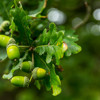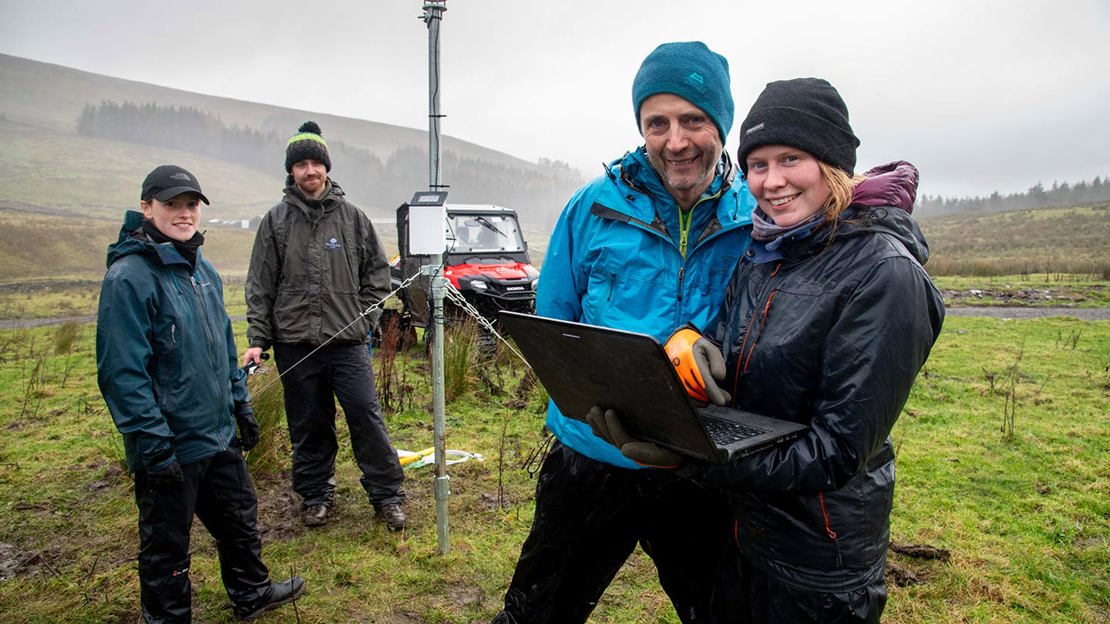Groundbreaking scientific research project at Snaizeholme will tackle the impacts of extreme weather

The UK's leading woodland conservation charity
One of the biggest pieces of scientific research ever undertaken in the English uplands will tackle the impacts of extreme weather.
New pioneering research will for the first time monitor how the creation of England’s biggest new native woodland could help stave off the worst effects of climate change, such as flooding.
Earlier this year, the Woodland Trust started work at Snaizeholme near Hawes, not only creating one of the largest contiguous new native woodlands in England, but also signalling the start of complex yet vital scientific research.
Over the course of the next 20 years or more, a team of world-leading scientists from the University of York and the University of Leeds will brave the site’s harsh weather conditions – which include 200cm of rainfall a year, making it the wettest place in Yorkshire - to collect detailed data. This will measure rainfall, soil properties and streamflow and track changes over time. This will help the scientists to understand, among many other things, how the flood mitigation benefits of new woodlands develop as the trees grow.
Already on site, scientists are using specialist equipment such as soil moisture and temperature sensors, weather stations and state of the art “lightning detectors” to measure extreme weather events.
The results of this research have the potential to directly help us adapt to the impacts of climate change by increasing our understanding of how trees can reduce flooding risk, capture and store carbon, and provide vital habitat for nature recovery across UK uplands.
Dr. John Crawford, Conservation Evidence Officer for the Woodland Trust, said:
“We know mature woodlands deliver a range of important benefits: they provide a home for nature, lock away carbon to fight climate change, and slow the flow of water helping to reduce downstream flooding. Less is known about new woodlands. Working together with world-leading researchers will allow us to take detailed measurements of how biodiversity and ecosystem functions change as the trees grow and the woodlands mature. The research has the power to be a game changer when it comes to how such a new site can combat the extreme effects of climate change. ”
Professor Dominick Spracklen from the University of Leeds, said:
“Restoring habitats across a whole valley has the potential to deliver big benefits for people, nature and climate. We have used a computer model to calculate that restoring the valley would reduce downstream flooding during a 1-in-50-year storm event by nearly 10%. To check that our predictions are correct , we are now installing special equipment to monitor soil and vegetation properties, rainfall and river flow. This will allow us to understand how the flood reduction benefits of the project grow as the native woodlands mature.”

Another key focus will be researching how establishing new trees alters the properties of soil.
Francesca Darvill, Sowerby PhD Researcher at the University of Leeds, said:
“We still know relatively little about how soil carbon changes after tree planting. Most previous studies lack information about how much soil carbon was present before trees were planted, making it difficult to know how soil carbon has changed. At Snaizeholme, we are making detailed measurements of the variability of soil properties across the site before the trees are planted. In years to come this will allow us to better understand how the trees have altered the soils. Crucially it will provide better information on how much carbon new woodland soils help to lock up.”
Dr Rob Mills at the University of York, said:
“Opportunities to create and restore habitats at this scale are rare in England. Snaizeholme provides a unique opportunity to understand how carefully restoring a rich mosaic of habitats provides a range of benefits for people, nature and climate. We know intact woodlands can be richly biodiverse ecosystems, and exploring how soil biodiversity, and the activity of soil microbes changes over time will be an important part of our work at Snaizeholme as the woodland develops'.”
Many centuries ago, the glacial valley at Snaizeholme would have been blessed with swathes of woodland stretching across the landscape but now the 561 hectares (1387 acres) site is almost devoid of trees. It’s a stark situation repeated across the Yorkshire Dales National Park, where total tree cover is less than 5% and ancient woodlands only make up 1% of that cover.
The Woodland Trust is planning to plant almost 291 hectares (719 acres) with native tree saplings. The careful approach to planting will see different densities of trees planted across the site to create groves, glades and open woodlands that gently transition into and connect with the other habitats, all delivered without the use plastic tree guards or herbicides.
It's a unique and complex piece of conservation work due to the range of habitats and species, the topography and elevation – not to mention the estimated 2m of rainfall per year. Tree planting will exist alongside huge restoration projects, including 113 hectares (279 acres) of blanket bog / deep peat, approximately 100 ha (247 acres) of limestone pavement and over 77.4 hectares (191 acres) of open valley bottom following Snaizeholme Beck.
Phase one of woodland creation at Snaizeholme has been funded by the White Rose Forest through its Trees for Climate funding programme. Trees for Climate, part of Defra’s Nature for Climate fund, provides grants for woodland creation within all Community Forest areas in England. Researchers at the University of Leeds are supported by the Peter Sowerby Foundation. The project at Snaizeholme is supported by Woodland Trust’s partners Aviva, B&Q, Screwfix, Bettys & Taylors of Harrogate.
Notes to editors
For enquiries please contact media@woodlandtrust.org.uk or 0330 333 5313.
About the Woodland Trust
The Woodland Trust is the largest woodland conservation charity in the UK. It has over 500,000 supporters. It wants to see a UK rich in native woods and trees for people and wildlife.
The Trust has three key aims:
- protect ancient woodland which is rare, unique and irreplaceable
- restoration of damaged ancient woodland, bringing precious pieces of our natural history back to life
- plant native trees and woods with the aim of creating resilient landscapes for people and wildlife.
Established in 1972, the Woodland Trust now has over 1,000 sites in its care covering approximately 29,000 hectares. Access to its woods is free so everyone can benefit from woods and trees.
About Trees for Climate and the Government’s Nature for Climate Fund
Trees for Climate is a woodland creation funding programme managed by England’s Community Forests and is part of the Government’s Nature for Climate Fund and England Trees Action Plan. Trees are at the forefront of the Government’s plans to achieve net zero emissions by 2050, to help to bend the curve of biodiversity loss, improve the environment and to create thousands of green jobs while better connecting people with nature. The England Trees Action Plan, supported by circa £750m from the Nature for Climate Fund, is a once-in-a-generation plan to help achieve this vision. We will see an unprecedented number of trees planted, protected and managed to deliver more for society, nature, the climate and the economy, setting us on a path to realise our longer-term ambitions for increased tree cover.
About the White Rose Forest
The White Rose Forest is the community forest for North and West Yorkshire and a founding partner of the Northern Forest. We are experts in woodland creation and work in partnership with landowners, local authorities, businesses, and communities to plant more trees across the region and improve our natural environment. We are planting millions of trees in our urban centres and countryside that will help manage flood risk, combat climate change, create jobs and provide happier and healthier places for us all to live, work in and enjoy.
About the Northern Forest
The Northern Forest has already established over 5 million new trees since 2018 and is transforming the landscape from coast to coast and in and around cities such as Liverpool, Chester, Manchester, Leeds, Bradford, Sheffield, York and Hull. A partnership between The Woodland Trust, the largest woodland conservation charity in the UK, and Community Forests: City of Trees, Mersey Forest, Humber Forest and White Rose Forest is delivering this ambitious project. The partnership is connecting people with nature through the Northern Forest, creating growth and investment opportunities, reducing climate change and flood risk, improving health and wellbeing, supporting the rural economy and developing innovative funding mechanisms for the future.
Yorkshire Dales National Park Management Plan 2019-2024, updated November 2021
® By 2040, resilient and responsive to the impacts of climate change, storing more carbon each year than it produces.
® Support landowners to create at least a further 450 hectares of native broadleaved and mixed woodland that enhances the National Park’s landscape by 2024, with priority given to projects that strengthen habitat networks, increase carbon storage and help to reduce flooding.
® By 2030, restore all degraded blanket bog/deep peat habitat to ecologically and hydrologically functioning bog that is actively sequestering and storing carbon, and is being managed sustainably.
If you're planning a visit to Snaizeholme
Please note that there is currently very limited parking near Snaizeholme, with parking only for pre-booked cars to the current Red Squirrel Trail. You can find details of the Red Squirrel Trail and how to book by picking up a copy of Go Nuts for Red Squirrels from any of the Yorkshire Dales National Park visitor centres.

